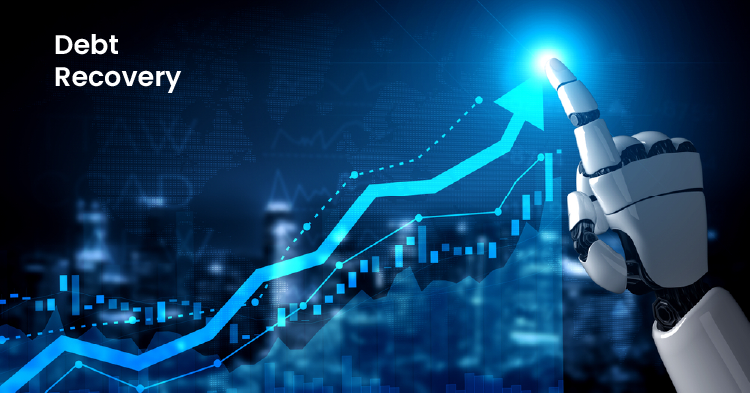Debt recovery is the process of collecting outstanding debts from individuals or businesses that have failed to make payments. With the advancements in technology, Machine Learning and Artificial Intelligence have become crucial tools in streamlining and optimizing the debt recovery process.
These technologies can analyze large amounts of data, identify patterns and make predictions about which debtors are most likely to pay, thereby improving the efficiency and effectiveness of debt recovery efforts. The use of Machine Learning and AI also reduces the workload for debt recovery agency, freeing them up to focus on more complex cases.

Debt recovery is important for a country's overall financial stability and economic growth. When individuals, businesses, and government entities are unable to pay their debts, it can lead to a significant increase in defaults, which can have a negative impact on the country's financial system. This can lead to decreased lending, reduced investment, and a decrease in overall economic activity.
Debt recovery is also important for maintaining the country's creditworthiness. When a country has a high rate of debt defaults, it can negatively impact its credit rating, making it more difficult for the country to access credit in the future. This can limit the country's ability to invest in infrastructure, education, and other key areas that are essential for economic growth and development.
Additionally, debt recovery helps ensure that the country's financial system remains healthy and stable.
The country's financial institutions can experience increased risk and decreased confidence in the financial system when they are unable to collect debts. This can lead to a decrease in lending and investment, which can harm the country's overall economic health.
To ensure effective debt recovery, a country needs to have a robust legal system in place that provides clear guidelines and processes for debt collection services. This includes having well-defined laws, regulations, and procedures for debt recovery, as well as a fair and transparent legal system that provides equal protection for both debtors and creditors.

Debt recovery is a critical aspect of financial management for both individuals and businesses. When a borrower defaults on a loan, it is the responsibility of the lender to take action to recover the outstanding debt. In the past, debt recovery was a manual and time-consuming process that relied on human judgment and intuition. However, with the advancement of technology, data science, and Artificial Intelligence have become crucial tools for optimizing the debt recovery process
Data science and Artificial Intelligence are revolutionizing the way debt recovery is performed. These technologies can analyze large amounts of data, identify patterns, and make predictions about which debtors are most likely to pay.
This information can be used to prioritize the most pressing cases and allocate resources more effectively. The use of data science and AI also reduces the workload for debt recovery agents, freeing them up to focus on more complex cases.
One of the key benefits of using data science and AI in debt recovery is the ability to automate repetitive tasks. For example, data science algorithms can analyze a borrower's payment history and predict the likelihood of default. This information can be used to prioritize which cases should be pursued first, ensuring that the most pressing cases receive the attention they need.
Additionally, AI systems can automate the collection process by sending automated reminders and follow-up messages to debtors. This not only saves time but also increases the chances of successful debt recovery.
Another advantage of using data science and AI in debt recovery is the ability to identify and predict trends in borrower behavior. For example, AI systems can analyze data on a borrower's spending patterns, employment history, and credit score to determine the likelihood of default. This information can be used to develop targeted debt recovery strategies, increasing the chances of successful recovery.
Data science and AI can also help to reduce the risk of human error. For example, manual data entry can result in mistakes, such as incorrect addresses or phone numbers. AI systems, on the other hand, can automatically verify and correct this information, reducing the risk of errors and improving the accuracy of debt recovery efforts.
One of the most important applications of data science and AI in debt recovery is the use of predictive analytics. Predictive analytics uses historical data to make predictions about future behavior. In the context of debt recovery, this means that data science algorithms can analyze a borrower's payment history and predict the likelihood of default. This information can help prioritize which cases to pursue first, ensuring that the most pressing cases receive the attention they need.

Another application of data science and AI in debt recovery is the use of natural language processing (NLP). NLP is a branch of AI that focuses on computer-human interaction using natural language.
In the context of debt recovery, NLP can be used to automate the collection process by sending automated reminders and follow-up messages to debtors.
This not only saves time but also increases the chances of successful debt recovery.
Companies can use data science and AI to actively improve the overall customer experience. By automating repetitive tasks and reducing the workload for debt recovery agents, customers are more likely to receive prompt and effective service. Additionally, AI systems can provide customers with personalized debt repayment plans, based on their financial situation and circumstances. This not only helps to improve customer satisfaction but also increases the chances of successful debt recovery.
Regularly reviewing and evaluating the effectiveness of data science and AI strategies is important to ensure that they align with the organization's goals and objectives. To maintain alignment, it is important to make adjustments as needed.
The use of data science and Artificial Intelligence in debt recovery is a game-changer. These technologies can streamline the debt recovery process, improve efficiency, reduce the risk of human error, and improve the overall customer experience. As technology continues to evolve, the use of data science and AI in debt recovery will likely become increasingly widespread, helping lenders to recover outstanding debts more effectively and efficiently.
In conclusion, the use of data science and AI in debt recovery can bring significant benefits to organizations, including improved efficiency, reduced risk of human error, and improved customer experience. However, to fully realize these benefits, organizations must invest in the right tools and technologies, train their debt recovery teams, and establish a clear strategy for using data science and AI. By doing so, they can optimize their debt recovery efforts and achieve better outcomes.
Get the latest posts in your email